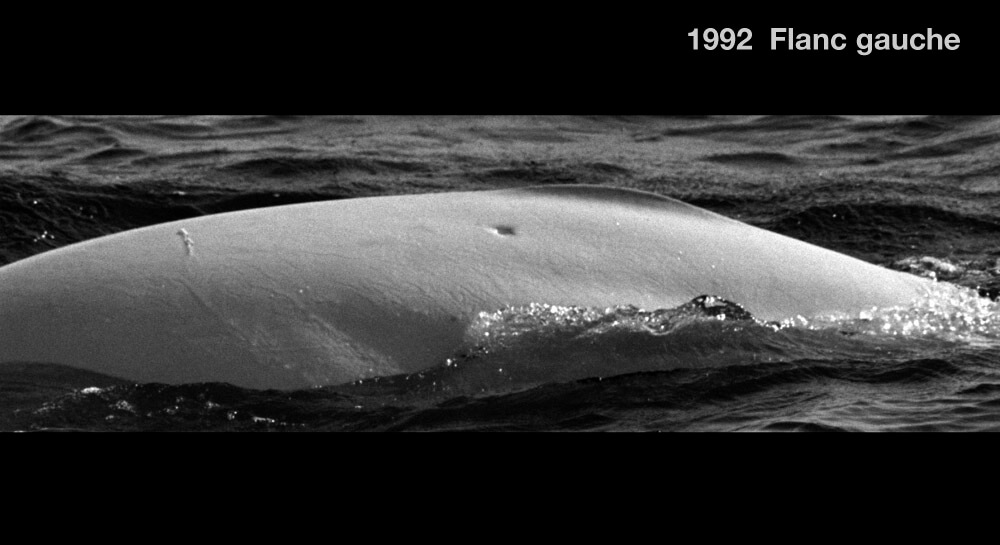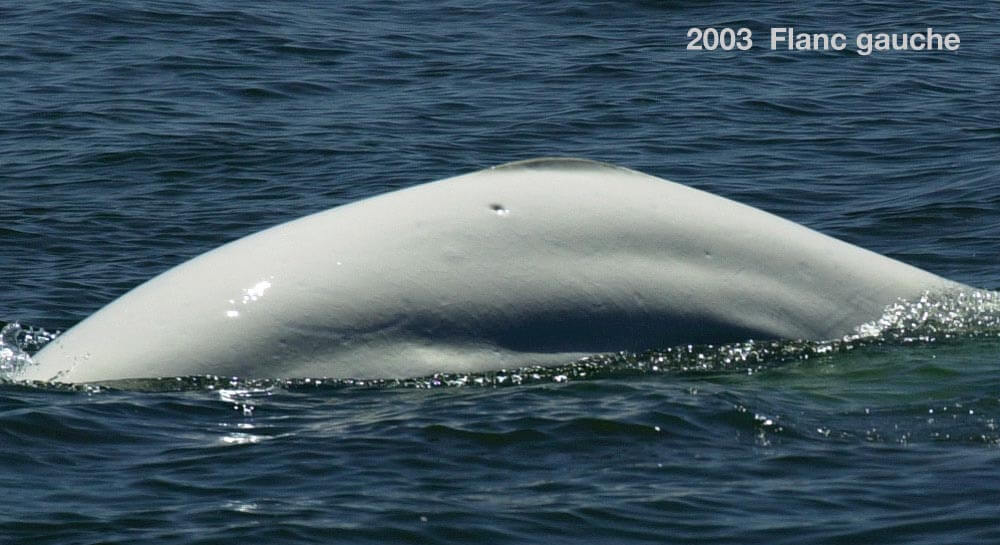Or Blanc
Beluga


Adopted by the municipalities of Salaberry-de-Valleyfield, Beauharnois and Châteauguay
-
ID number
DL0171
-
Sex
Presumed male
-
Year of birth
Before 1980
-
Known Since
1992
Distinctive traits
Or Blanc can only be recognized based on his left flank, as the markings on his dorsal crest are not sufficiently pronounced to confirm his identity from the right side. What distinguishes him from the left is the circle-shaped scar near his dorsal crest.
Life history
The first time Or Blanc is photographed in 1992, he is already pure white. Belugas fade from gray to white in colour between the ages of 12 and 16. Or Blanc was thus born before 1980.
Aside from changes in colouration, size as well as behaviour can also provide clues as to an animal’s age. In dead individuals, growth layers visible in the teeth, the number of ovulations in females, and changes in the lenses of the eyes are also indicators.
Or Blanc is observed in adult herds predominantly made up of males. He is affiliated with one of the two networks of males that ply the waters of the Saguenay Fjord. Another network of males, known as the “Downstream Boys”, also uses the head of the Laurentian Channel sector and the downriver portion of the Estuary. Even if their territories overlap, individuals from one network seldom rub fins with males of other networks.
When they reach adulthood, males tend to form stable groups of companions. These associations, which are established gradually, may play a role in belugas’ reproductive lives. Or Blanc has no known faithful companion. He has been seen regularly however with males Frimas and Dance-Sea.
How Or Blanc’s story unfolds will teach us volumes on the evolution of belugas’ social lives. By better understanding how belugas live, we will better be able to protect them.
Observations history in the Estuary
Years in which the animal was not observed Years in which the animal was observed
Latest news
Early in the day, we encounter a herd of 100 to 120 individuals not far from Ile Rouge. On the surface, we can observe krill. Although krill is not part of the beluga’s diet, it may well be their prey. Either way, there’s action in the current bar! Seabirds feed and dive around us. A minke whale is also maneuvering among all this wildlife. He even performs a technique known as “frog jumping”. We concentrate on the beluga whales, even if the presence of a fin whale offshore catches our eye. We approach small groups of around five individuals to photograph them. We recognize DL0014, Or Blanc and DL0743. In another, we see DL0240 and DL9056. Belugas appear to be feeding, diving and surfacing. A gull nearly steals a beluga’s fish! Not far from us, a humpback whale dives. We’re so lucky to be studying whales!
Or Blanc is spotted in a herd of some fifty adults off the coast of Anse à Pierrot (Pierrot cove) in the Saguenay Fjord. Slowly and in single file, the animals work their way downstream toward the St. Lawrence Estuary. Or Blanc is swimming in the company of eight belugas, all large males, including two of his most faithful companions: DL0204 and GraCY. At the same time as we carry out a photo study, we send out a drone for a flyover. The images are striking. These aerial images are used to estimate the belugas’ size, a new piece of information that we can add to their individual datasheets.
We’re observing Or Blanc at the mouth of the Fjord. He’s swimming in a herd of 60 or so belugas that are slowly making their way up the Fjord. Within the herd, we notice a few entirely white individuals – including females Blanche and her daughter Marguerite as well as DL0553 and males Gracy and DL0918 – though 40% of the belugas are gray or slightly gray. We also observe three newborns, two of which are the respective calves of Blanche and Marguerite. Mother and daughter are swimming side by side, each with their own offspring. We are thus witness to three generations of belugas: a first for our team.
The Saguenay is a place where cows and bulls of different generations mingle: male networks like Or Blanc’s mix with communities of females and young, as well as with groups of juvenile males.
We’re working in the Saguenay, near Cap Blanc. We’re in the presence of a herd of some forty belugas. The glare on the water somewhat complicates our surveys. We’ve spotted no less than three calves in the herd. The female Blanche is present, as is Or Blanc. Around twenty belugas, adults and young alike, form a loosely-knit group around which smaller groups of a few individuals gravitate. In front of us are six large males that we are trying to biopsy, to no avail.
You know what looks like a beluga whale? Wave foam. We shouldn’t call them “sheep”, we should call them belugas! And on this day in July, it’s windy and “sheepish”! Despite this, our research team’s eyes are sufficiently accustomed to spotting belugas to make out a herd at the entrance to Sainte-Marguerite Bay, on the Saguenay Fjord. The herd divides into small groups. We start by photographing five males, then a mixed group, then a group of a dozen belugas with four still gray. Or Blanc is in a group made up entirely of white males. He swims alongside Vita. Baie Sainte-Marguerite is one of the places where we see groups of males and females rubbing shoulders during the summer. In another group, we see Belibec and Athena.
Sponsor
The municipalities of Salaberry-de-Valleyfield, Beauharnois and Châteauguay adopted Or Blanc (2014) and participate in the solidary adoptions of Neige, Nics, Solidaire, Bilou and Cica with other riverside municipalities of the St. Lawrence (2014).
Click on the name below to discover texts, drawings and videos composed by children of participating schools on Facebook.
Or blanc was named by the 3th grade class of the École des Trois Sources in Châteauguay as part of the Our Beluga’s Name is… contest.
Concours Notre béluga s’appelle… Or blanc
Lors du choix d’un nom pour notre béluga, nous avons cherché des mots qui évoquent quelque chose de précieux, pour la valeur que ce mammifère marin peut avoir à nos yeux, mais aussi pour sa rareté. La comparaison au métal précieux qu’est l’or est accompagnée d’une autre comparaison, celle à l’Or bleu, surnom donné à l’eau, qui est non seulement l’habitat du béluga, mais aussi une ressource inestimable qu’il nous faut protéger.
Enfin, si l’or se décline en plusieurs teintes, c’est aussi le cas du beluga, dont la peau grise devient d’un blanc étincelant au fil des ans. La peau si blanche de notre beluga nous a permis de mieux connaitre son âge.
C’est la situation fragile des bélugas du Saint-Laurent, leur place dans la biodiversité mais aussi leur incroyable beauté qui rendent cet animal marin si précieux.
Pour illustrer leur choix de nom, les enfants ont créé une affiche sur laquelle ils ont écrit le texte suivant, accompagné de bulles d’eau contenant quelques mots autour des bélugas :
A l’image de l’eau que l’on surnomme Or bleu parce qu’elle est si précieuse, épuisable et fragile, nous avons choisi le nom de Or blanc pour notre beluga. L’or est un métal précieux. Le beluga l’est tout autant. Comme l’or qui brille au soleil, la peau blanche du beluga adulte scintille à la surface de l’eau du fleuve qu’il habite. Il faut protéger ce qui est précieux !
L’affiche créée par les enfants sera affichée dans notre école afin qu’elle soit vue par un très grand nombre de personnes.
Nous joignons à ce texte une photo de notre affiche et une de ses petits auteurs.



